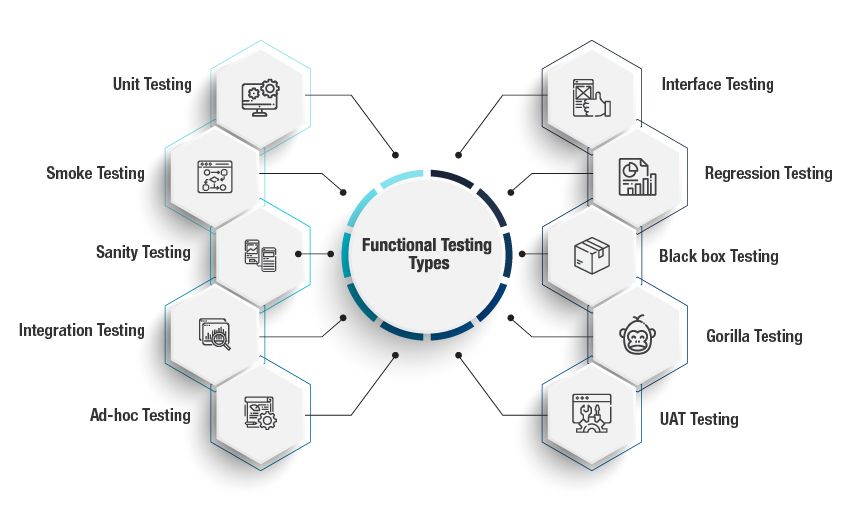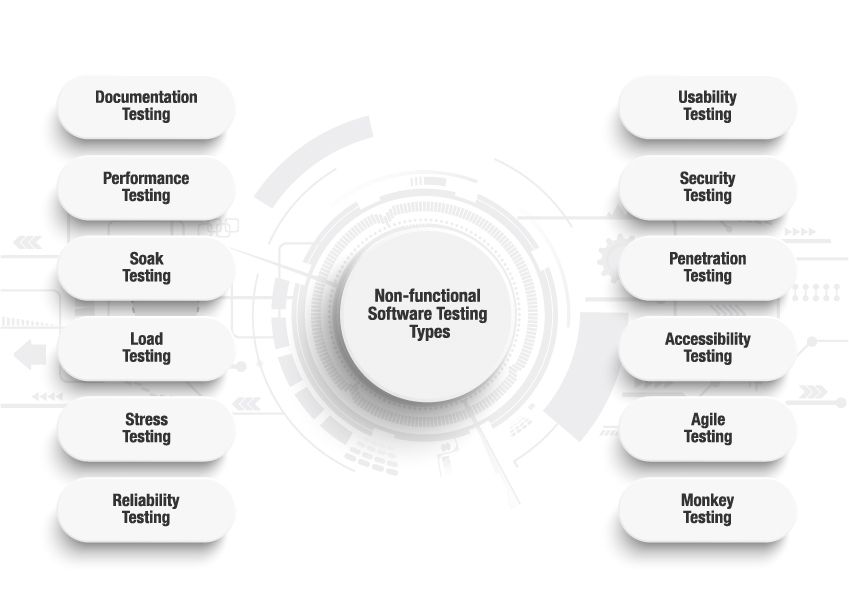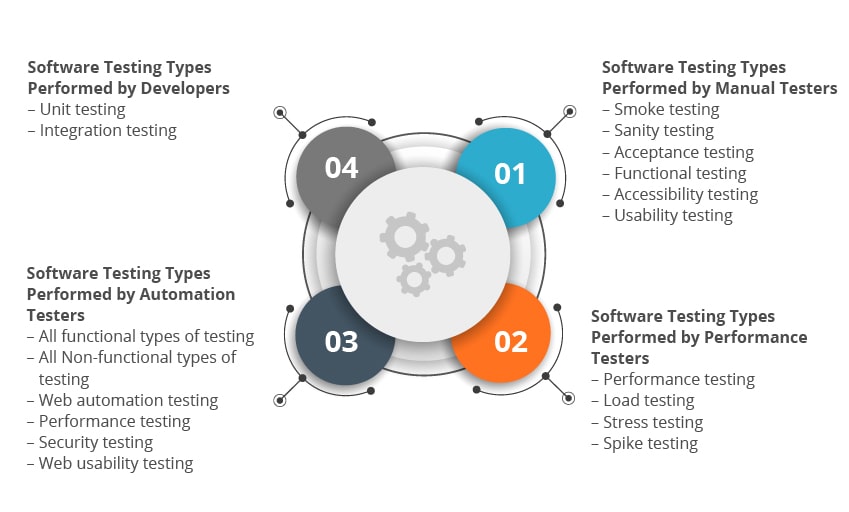Recommended Blogs
Types of Software Testing You Should Know
By Manjeet Kumar - Read time: 4 minutes

Table of Contents
-
- What are the Main Types of Software Testing?
- Why should Businesses take up Software testing?
- What are the Important Functional Testing types?
- What are the Important Non-functional Software Testing Types?
- Types of Software Testing Performed by Various Teams
- How to Achieve Effective Software Testing?
- Quick Recap – Comparison of Software Testing Types
- What’s the Ideal Software Testing Approach for Your Project?
- Conclusion
Software application and product development involve code analysis, design, and development, and the most critical process is software testing. This process of QA testing involves testing at the module and product levels, and also as a whole unit. Software testing consists of various types, such as functional, security, usability, integration, end-to-end, and more. These types ensure the software functions as expected under varying load and speed. Also, the process focuses on providing software that is secure from cyberattacks and is easily accessible to users, including users with disabilities.
Why should Businesses take up Software testing?
Any application or software should be validated and verified using software testing practices to ensure that it is free from bugs or errors. This process is also done to ensure whether the software accomplishes the technical requirements, as guided by the development and design.
A fully-functional software product plays a vital role for businesses in today’s digital world as devices and gadgets are being used by majority of the population. As technologies are being implemented to ease the routine activities of a human by using various digital apps, more of online transaction activities such as online shopping, online banking, online doctor consultation, etc. are on the rise.
At this crucial juncture, the prominence of software testing comes in.
Following are four key reasons that will help you understand as to why Businesses should go for software testing services
1. Product quality:
A product should be of utmost value to a user. Product compatibility is also important to ascertain the quality of the product. A product must be compatible to function well with different operating systems, devices, and networks.
2. Product functionality:
The product developed should be fully-functional. User experience and customer experience is important for businesses to evaluate their web app, mobile app, desktop app or for any solutions and hence software testing should be leveraged.
3. Security testing is a priority:
In today’s competitive world, organizations cannot afford the theft of data, which can prove to be disastrous. Through a well-laid down testing strategy, the products that are being built should be security tested to ensure apps are secure, safe and high-performing. Thus, with the right use of security testing methodologies, various threats and vulnerabilities can be removed from software.
4. QA Cost-effectiveness:
By leveraging the services of an independent testing services provider, your QA costs can be significantly reduced. Carrying out software testing activities will prove to be cost-effective for organizations, as the cost and time to build a fully functional product will be considerably less. If bugs and defects are found early on in the software development process, through the application of software testing, then cost is reduced to a great extent.
There are various types of software testing that should be followed to achieve different objectives of the application under test while testing software applications.
What are the Main Types of Software Testing?

Though there are different types of software testing in practice but, the two major categories are Functional and Non-functional types of testing along with manual, automated and system programming testing types.
Functional testing
In software testing tells us what the system actually does and is used to verify how each function of the software application behaves as specified in the software requirements specification document. This type of QA testing helps to verify whether the actual output is matching the expected output and the testers need not look upon the source code of the application.
Non-functional testing
Revolves around the specificity of how well the system performs under various conditions. It refers to various other forms of software testing and some of the most common testing methods are performance, load, stress, security, compatibility testing.
Manual Testing
It is the process of testing the software by humans to verify the software quality for which exclusive test cases are written and tested for their pass or fail status. There are many types of manual testing and some of the most common are smoke testing, functional testing, sanity testing.
Automated testing
In recent years, this has been dominating the testing field as certain open source and paid automation testing tools are used to find the defects and bugs. Software automated testing process involves the creation of test scripts, running these test scripts and logging the bugs in defect management software.
System testing:
This type of qa testing includes many testing methods and is used to validate the software as a whole with respect to software, hardware, and networks. It usually tests the fully integrated software product to exclusively evaluate end-to-end system specifications. It enables to test, validate and verify both the application architecture and validate based on the business requirements to ensure a fully functional product. Though there are more than 100+ types of software testing, but in this article, some of the most common QA testing types have been detailed and have been broadly categorized under Functional and non functional testing methods.
Exploratory Testing:
In this type of software testing, the engineers can select any methodology to test the software. It’s an unscripted approach that can be functional or non-functional. In this approach, developers can use their knowledge, skills, and abilities to run the QA process on the software they developed. Exploratory testing combines the tester’s experience with a structured approach to quality assurance. It helps discover bugs that might have been missed during the structured testing phases. QA engineers can annotate defects and add assertions to convert the user story into a test case.
What are the Important Functional Testing types?
 There are many important functional testing methods like Unit testing, smoke and sanity testing, black box testing, and many more.
There are many important functional testing methods like Unit testing, smoke and sanity testing, black box testing, and many more.
Unit testing:
This is the initial or preliminary testing type performed by the developers and is usually focused on the smallest unit of software design. Evidently, testing is done on an individual unit or group of inter-related units to check their functionality. It is often done by the developers or programmers and they use sample input to observe the corresponding output.
Smoke Testing:
This is another important testing method done by software testers. This type of software testing helps to make sure that software or the application under testing is ready or stable for further testing. Only if the software build is stable, the testers accept the build and continue to perform the further process of software testing.
Sanity testing:
This is an effective testing method used to verify the newly added functionalities and is usually executed before any detailed functional or regression tests are executed. This method of testing is taken up as soon as the build is received to check whether the new code changes introduced are working as expected.
Integration testing:
It is usually performed by programmers where the individual test units are combined and tested as a group. This testing method is critical for the software as it exposes faults in the interaction between integrated units. Integration testing is taken up for testing unit components that are already tested and build a program structure.
Ad-hoc testing:
This is a sudden and unplanned testing methodology usually performed without planning and without any test design documents. The software tester only tries to break the system by randomly trying the system’s functionality and is usually performed by the testing team. The team should have a good understanding of the domain, and workflows of the application to find any defects and to break the software.
Interface testing:
This form of testing is taken up when software provides support for one or more interfaces such as the graphical user interface, the command-line interface or application programming interface to know how they interact with its users or other software. This interface truly serves as a medium for the software to accept the input from the user and deliver the output to the user.
Regression testing:
Regression testing is an effective method of software testing taken up each time when a new module is added in the program. This testing type ensures that the whole software component works properly even after adding new components. This method helps to check and ensure the existing functionalities are unaffected due to the newly added functionalities.
Black box testing:
Black box is an important software testing method wherein testers are not required to know the coding or internal structure of the software. In Black box testing,the method completely depends on testing system with various inputs and validating the results against the expected output.Black box testing has its independent Software Testing Life Cycle (STLC) and the main focus of the black box testing method is validating the functional requirements. It is one of the part of box testing, and white box testing is the another one.
White Box Testing:
White box testing is a software testing methods wherein testers are aware of the internal structure/ implementation/ design of the software. In white box testing, the approach focuses on verifying the input and output flow, improving the usability, design and increasing the security of the software. White box testing is the converse process of Black box testing and it is known as white box penetration testing, unit testing, white box mutation testing, etc.
Gorilla testing:
This type of software testing technique focuses on heavily testing of one particular module. It is performed by quality assurance teams to test one or few functionalities thoroughly or exhaustively by having multiple testing teams to test the same functionality to know if there are any variations.
User acceptance testing:
This is an important that is taken up as a final step (pre-production) and is shown to the product owner to evaluate whether all features work in accordance with the requirements detailed. If the UAT is successful, then the software is deployed into the production environment. It allows the customer to either accept or reject the application.
What are the Important Non-functional Software Testing Types?
 There are many important non-functional testing methods like Usability testing, performance testing, stress testing, and many more.
There are many important non-functional testing methods like Usability testing, performance testing, stress testing, and many more.
Documentation testing:
This form of testing is done to validate the documented artifacts such as the software requirements, test plan, and also includes traceability matrix, and test cases. It gives an idea about the artifacts of the application under test.
Performance testing:
This is a very important method of non-functional testing and is performed to assess product readiness under the influence of heavy loads. It is carried out with meticulous testing procedures to determine the responsiveness, reliability, and stability of the software application under varying user loads. It is usually achieved by measuring response times, throughput, and resource-utilization levels for the application under test.
Soak Testing:
It is a type of performance testing, wherein the software is subjected to load for over a significant duration of time. Soak testing may go on for a few days or even for a few weeks. This type of testing is conducted to find errors that result in the degeneration of software performance with continued usage.
Load testing:
This is a vital form of software testing used to verify the system/application’s ability to handle the expected number of transactions. It also verifies the system/application behavior under both normal and peak load conditions.
Stress testing:
This method of testing is performed to verify the behavior of the system once the load increases more than its design expectations.
Reliability testing:
This is an effective testing method that checks whether the software can perform a failure-free operation for a specified period of time in a particular environment.
Usability testing:
Usability testing is a core test that cannot be ignored since it determines whether a particular software system will be able to meet its intended purpose. Usability testing is quick to determine the system’s strengths and weaknesses and evaluates the overall usability of the product.
Security testing:
As businesses continue to face the current rampant cyber-attacks, enterprises have strong concerns around their customer’s data and application security. Hence, it is critical for businesses to leverage security testing to safeguard their applications from cyber threats and vulnerabilities.
Penetration testing or Pen testing:
Penetration testing is also known as pen testing and is a type of security testing. Businesses should adopt it to evaluate the security of the application and be ensured of threat free applications.
Accessibility testing:
This type of testing ensures the application or the business website is accessible to people with disabilities (deaf, blind, etc.).
Agile testing:
This method of software testing practice follows the principles of the agile manifesto and emphasizes the testing from the perspective of customers. Today, businesses place their customer experience as the highest importance. It is usually performed by the quality assurance teams.
Monkey testing:
This method involves performing abnormal actions on the software application deliberately in order to verify the stability of the application.
Types of Software Testing Performed by Various Teams

Quick Recap – Comparison of Software Testing Types
| Software Testing Types | Description |
|---|---|
| Functional Testing | Verifies the functional aspects of the software application. |
| Unit Testing | Focuses on the smallest unit of the software design. |
| Smoke Testing | Ensures the software is stable enough for further testing. |
| Sanity Testing | Verifies newly added functionalities. |
| Integration Testing | Exposes faults in interactions between integrated units. |
| Ad-hoc Testing | Unplanned testing performed without documentation or test design. |
| Interface Testing | Verifies user input handling and relevant output delivery. |
| Regression Testing | Ensures components work properly after changes or additions. |
| Black Box Testing | Testing without knowledge of internal code or structure. |
| White Box Testing | Testing with full knowledge of internal workings and code structure. |
| Gorilla Testing | Intensively tests one particular module. |
| User Acceptance Testing | Evaluates whether features meet requirements and user needs. |
| Non-functional Testing | Checks how well the system performs under various conditions. |
| Documentation Testing | Validates documentation such as requirements and test plans. |
| Performance Testing | Assesses product readiness under heavy loads. |
| Soak Testing | Subjects the software to a load for an extended period. |
| Load Testing | Verifies the system’s ability to handle expected transaction volumes. |
| Stress Testing | Checks system behavior when the load exceeds design expectations. |
| Reliability Testing | Checks software can operate failure-free for a specified period in a given environment. |
| Usability Testing | Determines if the software meets its intended purpose for users. |
| Security Testing | Safeguards applications from cyber threats and vulnerabilities. |
| Penetration Testing | Evaluates application security to identify and address threats. |
| Accessibility Testing | Ensures the application or website is accessible to people with disabilities. |
| Agile Testing | Follows Agile principles and emphasizes customer-focused testing. |
| Monkey Testing | Performs abnormal or random actions on the application deliberately. |
What’s the Ideal Software Testing Approach for Your Project?
One thing you should know is that not every approach is a one-size-fits-all solution. It totally depends on your project requirements. The proper approach will involve various testing techniques and strategies to help you ensure the optimal quality of your software in production. It must also be able to adapt to changing project requirements. When selecting an ideal software testing approach, one must consider the following:
- Risks are bound to occur, so consider every possible risk during testing.
- Ensure your testing strategy satisfies your project objectives and stakeholders’ requirements.
- Is the software under test meeting all regulations? Ask this question when analyzing the testing approach.
How to Achieve Effective Software Testing?
If you are a business or an enterprise, you might be concerned after looking at the complete list of software testing methods and services available. It is important to know about the different types of software testing and at the same time, to achieve the best and effective testing services based on your project or application type. Additionally, a software testing services provider will be the best choice to choose from. This will help you get the complete benefit of effective software testing and you can be ensured of faster releases and quality software.
Conclusion
Enterprises and businesses should take a stance on their product development and any delay caused by either delayed or late testing will have a direct impact on the total cost of a project. It further has an adverse effect on software quality. Hence, in order to prevent such delayed testing impacts, enterprises should understand the various software testing method types and have to take the complete advantage of testing by leveraging a next-gen testing services provider. Independent software testing services providers with in-house testing experts are bound to deliver effective results. They have professional QA testers, accelerators, and automation testing frameworks to enable effective testing system and identify bugs and ensure to deliver quality software.
FAQs
-
Software testing includes functional and non-functional testing, with further sub-types like unit, integration, system, and acceptance testing, as well as performance, security, and usability testing.
-
Software testing ensures that applications are reliable, secure, and high-performing before release. It helps detect defects early, reduce risks, enhance UX, and ensure compliance with industry-specific standards. it also helps improves software quality by mitigating costly errors and security vulnerabilities.
-
AI in software testing enhances test automation, defect detection, and predictive analytics. It accelerates test execution, improves accuracy, and identifies patterns in test data. AI-powered tools optimize test coverage, reducing manual efforts while ensuring efficient, high-quality software releases.
-
Regression testing ensures that recent code changes do not give rise to new defects. It involves re-running test cases to verify existing functionality remains intact. This helps maintain software stability, especially after updates, bug fixes, or feature enhancements.
-
Tx provides end-to-end software testing services, including functional, performance, security, automation, and AI-driven testing. With industry expertise and cutting-edge tools, Tx ensures high-quality, secure, and scalable applications, helping businesses achieve faster time-to-market and better user experiences.”
Discover more
Stay Updated
Subscribe for more info

